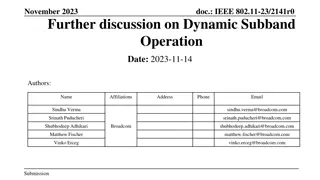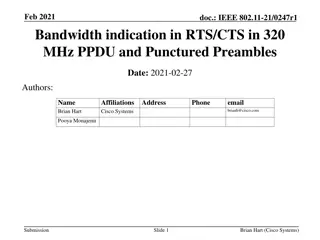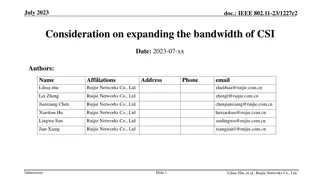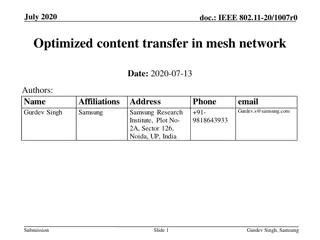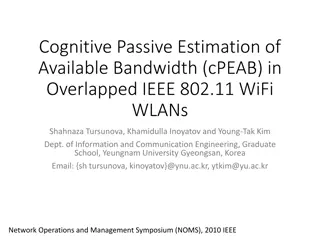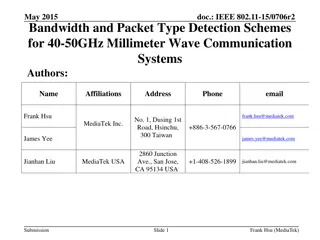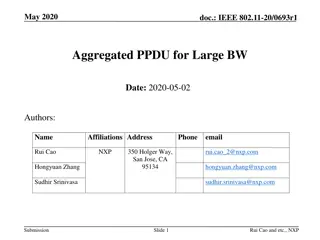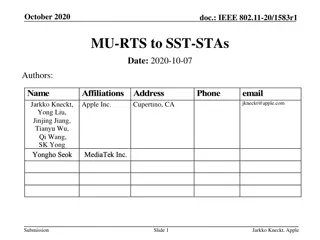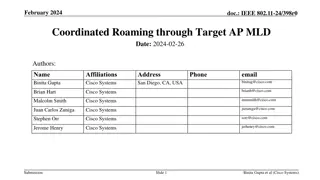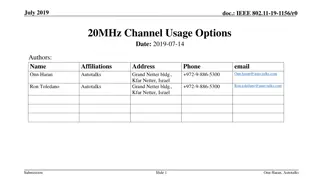Proposal for Efficient Bandwidth Utilization in IEEE 802.11 Networks
This proposal aims to address the inefficient utilization of bandwidth in IEEE 802.11 networks by allowing stations to transmit on idle channels within their operating bandwidth. The document discusses the problem statement, high-level solution, relevant capabilities of transmitters and receivers, proposed operating modes, regulations, and concludes with straw polls. It emphasizes the need for careful design in utilizing non-primary channels and outlines qualifying conditions for efficient channel utilization.
Download Presentation

Please find below an Image/Link to download the presentation.
The content on the website is provided AS IS for your information and personal use only. It may not be sold, licensed, or shared on other websites without obtaining consent from the author. Download presentation by click this link. If you encounter any issues during the download, it is possible that the publisher has removed the file from their server.
E N D
Presentation Transcript
doc.: IEEE 802.11-23/0034r1 February 2023 Non-Primary Channel Utilization Date: 2023-01-09 Authors: Name Affiliations Address Phone Email Sindhu Verma sindhu.verma@broadcom.com Shubhodeep Adhikari shubhodeep.adhikari@broadcom.com Broadcom Matthew Fischer matthew.fischer@broadcom.com Vinko Erceg vinko.erceg@broadcom.com Submission Slide 1
doc.: IEEE 802.11-23/0034r1 Abstract This is a proposal to allow the utilization of some portion of the operating bandwidth when another portion of the operating bandwidth has been detected as BUSY Submission Slide 2
doc.: IEEE 802.11-23/0034r1 Overview Problem Statement High-level Solution Relevant Transmitter capabilities Relevant Receiver capabilities Proposed Operating Modes Regulations and Precedents Conclusion Straw Polls Submission Slide 3
doc.: IEEE 802.11-23/0034r1 Problem Statement If the primary 20 MHz channel is busy, an 802.11 STA currently does not transmit on any of the portion of the operating bandwidth, even when those portions are idle Such inefficient bandwidth utilization in 802.11 causes more loss with increasing operating bandwidth. For example, in 802.11be, a busy 20MHz primary channel prevents a STA from accessing an idle 300 MHz of remaining bandwidth. Competing unlicensed technologies operating in the same bands, such as LAA and NR- U, do not have such limitations. They neither have any dependence on any primary 20MHz channel for system information like beacons, nor any need for backward compatibility with legacy devices that operate only on the primary 20MHz channel. However, both these requirements are true for 802.11, which also means that utilization of non-primary channels in 802.11 needs careful design. A channel in this presentation denotes a 20MHz bandwidth unit as defined by regulations and the 802.11 and other unlicensed standards. Submission Slide 4
doc.: IEEE 802.11-23/0034r1 High-level Solution The problem of inefficient bandwidth usage can be alleviated by allowing a STA to transmit on a subset of channels that are a part of its operating bandwidth if they are idle and provided other qualifying conditions are met The qualifying conditions need to consider the inherent dependence of 802.11 on a primary 20MHz channel and specifically, the following: Devices of 802.11be and prior standards can transmit only when the primary 20MHz channel is available. Beacons and similar control messages are transmitted only on the primary 20MHz channel Transmitting on any subset of channels of a link renders the transmitting device blind on the channels that are left out from the perspective of CCA. Anytime that a transmitting device is blind on a set of channels for the purpose of CCA, it needs to perform conservative access measures on returning to it so as not to penalize the already transmitting devices. Multiple kinds of transmitter/receiver capabilities (detailed next) Submission Slide 5
doc.: IEEE 802.11-23/0034r1 Relevant Transmitter capabilities Capability type 1: A device can perform full CCA (i.e. ED + virtual CCA) in parallel on multiple channels in its operating bandwidth, including the primary 20MHz. If the primary is BUSY, CCA continues on other channels. This reduces the delay in gaining access to non-primary channels Capability type 2: A device can perform full CCA on only one channel at a time. So, it can perform full CCA on other channels after it determines the primary is busy but the packet is not relevant to this STA and/or BSS These devices cannot perform full CCA in parallel on multiple channels. Such sequential CCA can delay gaining access on the idle non- primary channels CCA on non-primary channels is performed only during the occupancy of the primary channel which is determined by examining the duration of the PPDUs and/or TXOP occupying the primary channel Submission Slide 6
doc.: IEEE 802.11-23/0034r1 Relevant Receiver capabilities Capability Type 1: A receiving device performs preamble/packet detection in parallel on multiple channels in its operating bandwidth, including the primary channel. This means that a transmitter can choose any of those non-primary channels to transmit to the receiver on. Capability Type 2: A receiving device performs preamble/packet detection on only one channel at a time. So, it can perform preamble/packet detection on other channels after it determines the primary channel is busy. This is suitable for devices which cannot perform preamble/packet detection in parallel on multiple channels. Submission Slide 7
doc.: IEEE 802.11-23/0034r1 Proposed Operating Modes: Option 1 (1) This type of operation is possible if the Receiver has capability Type 1 (i.e. parallel preamble/packet detection on multiple channels) and the Transmitter has capability Type 1 or 2 (i.e. parallel CCA on multiple channels or sequential CCA on one channel at a time). In this option, non-primary channel utilization is possible only if the receiver supports preamble/packet detection on multiple channels in parallel The Transmitter and Receiver agree on a set of anchor channels The number of anchor channels is less than or equal to the number of channels the receiver supports parallel preamble/packet detection on. But it can be more than the number of channels the transmitter supports parallel CCA on. The anchor channels can be equally spaced in the operating bandwidth of the transmitter/receiver and the first anchor channel is the primary 20MHz channel Any transmissions always include at least one of the anchor channels Submission Slide 8
doc.: IEEE 802.11-23/0034r1 Proposed Operating Modes: Option 1 (2) In case the number of channels the Transmitter supports parallel CCA on, is smaller than the number of anchor channels, the transmitter can partition the anchor channels into smaller sets with the same number of channels as it supports parallel CCA on and where it starts fresh CCA processes and medium synchronization processes while moving from one set to the other. The primary 20MHz channel is not a part of a transmission only if it is occupied by an OBSS and only for that duration. The perspective of the transmitter alone matters. Since the receiver is capable of preamble/packet detection in parallel on the other anchor channels, it does not matter if it sees the OBSS on the primary 20MHz or not. Since the number of anchor channels is less than or equal to the number of channels the receiver supports parallel preamble/packet detection on, and the anchor channels would be negotiated, the receiver would be capable of preamble/packet detection on any of those channels irrespective of the primary 20MHz being busy. Submission Slide 9
doc.: IEEE 802.11-23/0034r1 Proposed Operating Modes: Option 2 (1) This type of operation is possible if the Receiver has capability Type 1 or 2 and the Transmitter has capability Type 1 or 2. In this option, non-primary channel utilization is possible even if the receiver supports preamble/packet detection on only one channel at a time. In that case, the receiver which supports preamble/packet detection on one channel at a time, switches to the alternative channel after determining the relevance and duration of the OBSS occupancy of the primary channel. Transmitter and Receiver agree on an order of trying different channels for data exchange without there being any anchor channels: The order for example, is Set1, Set2, etc. Transmitter performs CCA on the first channel or set of channels in the sequence Set1, Set2, etc. This first set includes the primary 20MHz channel. If EDCA completes (i.e. the device wins channel access) on the primary and zero or more channels of Set1, it transmits on those channels. Slide 10 Submission
doc.: IEEE 802.11-23/0034r1 Proposed Operating Modes: Option 2 (2) If no channel that corresponds to Set1 is available and the primary 20MHz channel is occupied by OBSS, the transmitter attempts to transmit on the second channel or set of channels Set2 only for the duration for which the primary 20MHz channel is busy. This continues till all channels are seen to be unavailable. The control returns to the first set Set1 once the duration determined by CCA (e.g. NAV or PPDU length) on the primary 20MHz channel expires. Upon returning to the primary 20MHz channel, Medium Synchronization process on primary need not be used if the return is before the expiry of the decoded OBSS duration Submission Slide 11
doc.: IEEE 802.11-23/0034r1 Proposed Operating Modes: Option 2 (3) This option requires a common understanding between Transmitter and Receiver of the primary 20MHz channel being occupied by OBSS and of any other channels being not available. Below are two ways to achieve it: Implicit: Transmitter and Receiver hope to see the same OBSS on the primary 20MHz channel and then move to the next set of channels There can be a threshold set on the signal strength from the OBSS to increase the probability that both transmitter and receiver see the OBSS. Similar process for determining whether other channels are busy/idle Explicit If there is a control link, the transmitter can indicate on it that it has detected OBSS/or other busy activity and is moving on to the next set of channels Some OBSS include identification information within the preamble and/or MAC portion of the frame. This can be possible in a coordinated system. Submission Slide 12
doc.: IEEE 802.11-23/0034r1 Regulations and Precedence The behavior described here is specified by the ETSI harmonized standard for 5 GHz (EN 301 893) The behavior is predicted to be copied into the ETSI rules for 6GHz Both options are supported by LAA and NR-U. Submission Slide 13
doc.: IEEE 802.11-23/0034r1 Conclusion This presentation discussed the need to eliminate a long standing limitation of 802.11 viz. its dependence on the availability of a single 20MHz primary channel for any transmission or reception to take place. Other technologies which have multi-channel (wideband) operation in the unlicensed spectrum, do not share this limitation We have proposed methods to realize utilization of non-primary channels even if the primary 20MHz is unavailable. The methods consider and are compatible with a wide range of capabilities for the transmitter/receiver and also coexistence with legacy devices. Submission Slide 14
doc.: IEEE 802.11-23/0034r1 Straw Poll 1 Do you support the following feature in UHR: Non-primary transmission: The concept in which an AP that finds the primary channel to be busy under TBD conditions, can employ techniques to access and transmit on the idle non-primary channels under TBD conditions Y/N/A Submission Slide 15





